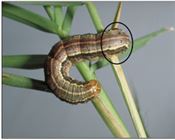Scout Fields Now For Fall Armyworm

WEST PLAINS, MO.
Fall armyworms have been found in southwest Missouri according to Sarah Kenyon, agronomy specialist with University of Missouri Extension.
Fall armyworm can be identified by the appearance of four black spots forming a square on the eighth abdominal segment and a pronounced inverted Y-shaped white mark on the head.
“If armyworms are found in pasture or hayfields, the best option is to graze or harvest as soon as possible to minimize damage. Spray decisions depend on the value of the crop and the stage of crop growth,” said Kenyon.
According to Kenyon, if there are four or more half-grown or larger worms per square foot the economic threshold has been reached, and spaying may be warranted.
The adult moths migrate from the south and lay eggs that hatch into the armyworm larvae. The armyworm larvae will march across fields consuming green forage. They have the potential to devastate forages and row crops completely.
More than 60 plants have been reported as hosts of the fall armyworm, including corn, grain sorghum, alfalfa, grass pastures and hayfields, and vegetable crops.
“Scouting is best done in the early morning hours, in the late evening, or on cloudy days because newly hatched larvae avoid light. The newly hatched larvae will feed on the lower leaves of plants to reduce light intensity,” said Kenyon.
To determine the presence of small larvae scout plant debris on the ground and for feeding damage on lower plant foliage. As larvae grow, they will feed higher on the host plant even during daylight hours.
For more information on control options for fall armyworm contact MU Extension Agronomy Specialist Sarah Kenyon at (417) 256-2391 or kenyons@missouri.edu.
More information can be found in the MU guide sheet G7115 "Management of the Armyworm Complex in Missouri Field Crops" available at any county extension center or online at http://extension.missouri.edu. ∆